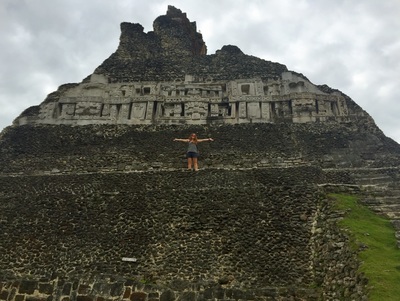10 Common Causes of Uterine Displacement
Your uterus can move!
She's held in place by many different ligaments in the pelvis and the connective tissue stretches and moves with various activities and impact. Most of the time, our body balances itself.
Yet, over time, injury or chronic habits may setup bad patterns that can lead to pain or dis-ease.
With menstruation, a uterus doubles in size and weight every month, so if she's in the wrong place, it can hurt! Sometimes painful periods are actually due to inflammation &/or stagnation caused by the uterus being displaced.
Here are 10 Common Causes of Uterine Displacement:
1. Injury to the sacrum or tailbone- Falls or injuries such as car accidents may stretch the uterine ligaments and shift the position of the uterus. Scar tissue may result overtime, which can burden the sacral nerve roots to the pelvic organs.
2. Repetitive, high-impact activities- Jarring motions may damage uterine ligaments that hold it in proper position. Weak pelvic floor muscles compound this problem.
3. "Sitting is the new smoking"- being sedentary has many ill health effects but sitting for long periods also constricts the blood and lymphatic flow that supports the uterus. Sitting with tight jeans or belts on is even worse for pelvic organs.
4. Chronic constipation- the colon sit behind the uterus and if the colon is chronically full, it can place forward pressure on the uterus.
5. Pregnancy and birth- Our bodies are well designed for birth but having multiple pregnancies close together may not give the pelvis proper time to heal and strengthen. Three years is generally recommended between births with special care taken after birth to avoid heavy lifting. In situations where birth was traumatic, extra care and rest should be taken for the mother to recuperate.
6. Trauma- Physical and emotional trauma, especially in cases of rape and sexual abuse, affect the nervous system and muscular patterns in our bodies. This is one of the reasons why emotional releases are very common with ATMAT.
7. Running on cement- Uterine ligaments are pulled forward and downward when our feet hit the pavement. Think of a rubber band constantly being stretched. Trail running and proper footwear make a huge difference!
8. High heels- The pelvis is tilted forward in high heels and the uterus will follow.
9. Heavy lifting during your period- Because the average uterus doubles in weight with menses, there is increased risk of ligamentous and muscular strain during this time.
10. Chronic back spasms- When muscles are chronically tight, there is lack of blood flow and therefore oxygen and nutrient supply to the area. This may result in pain and lack of mobility by restricted movement in the pelvis. The uterus does not like to feel cramped!
Arvigo Techniques of Maya Abdominal Therapy® is a great tool for supporting an optimal uterus position and decreasing pain by supporting hemodynamics in the pelvis.
If you are in the Portland area and would like to work with me, click here.
To find an Arvigo® practitioner in your area, click here.
In Health,
Dr. Sweet
She's held in place by many different ligaments in the pelvis and the connective tissue stretches and moves with various activities and impact. Most of the time, our body balances itself.
Yet, over time, injury or chronic habits may setup bad patterns that can lead to pain or dis-ease.
With menstruation, a uterus doubles in size and weight every month, so if she's in the wrong place, it can hurt! Sometimes painful periods are actually due to inflammation &/or stagnation caused by the uterus being displaced.
Here are 10 Common Causes of Uterine Displacement:
1. Injury to the sacrum or tailbone- Falls or injuries such as car accidents may stretch the uterine ligaments and shift the position of the uterus. Scar tissue may result overtime, which can burden the sacral nerve roots to the pelvic organs.
2. Repetitive, high-impact activities- Jarring motions may damage uterine ligaments that hold it in proper position. Weak pelvic floor muscles compound this problem.
3. "Sitting is the new smoking"- being sedentary has many ill health effects but sitting for long periods also constricts the blood and lymphatic flow that supports the uterus. Sitting with tight jeans or belts on is even worse for pelvic organs.
4. Chronic constipation- the colon sit behind the uterus and if the colon is chronically full, it can place forward pressure on the uterus.
5. Pregnancy and birth- Our bodies are well designed for birth but having multiple pregnancies close together may not give the pelvis proper time to heal and strengthen. Three years is generally recommended between births with special care taken after birth to avoid heavy lifting. In situations where birth was traumatic, extra care and rest should be taken for the mother to recuperate.
6. Trauma- Physical and emotional trauma, especially in cases of rape and sexual abuse, affect the nervous system and muscular patterns in our bodies. This is one of the reasons why emotional releases are very common with ATMAT.
7. Running on cement- Uterine ligaments are pulled forward and downward when our feet hit the pavement. Think of a rubber band constantly being stretched. Trail running and proper footwear make a huge difference!
8. High heels- The pelvis is tilted forward in high heels and the uterus will follow.
9. Heavy lifting during your period- Because the average uterus doubles in weight with menses, there is increased risk of ligamentous and muscular strain during this time.
10. Chronic back spasms- When muscles are chronically tight, there is lack of blood flow and therefore oxygen and nutrient supply to the area. This may result in pain and lack of mobility by restricted movement in the pelvis. The uterus does not like to feel cramped!
Arvigo Techniques of Maya Abdominal Therapy® is a great tool for supporting an optimal uterus position and decreasing pain by supporting hemodynamics in the pelvis.
If you are in the Portland area and would like to work with me, click here.
To find an Arvigo® practitioner in your area, click here.
In Health,
Dr. Sweet













 RSS Feed
RSS Feed